Technologies in Inclusive Education: Solution or Challenge? A Systematic Review
Abstract
1. Introduction
Theoretical Framework
- Inclusive Education
- Technologies
2. Materials and Methods
2.1. Eligibility Criteria and Information Sources
2.2. Search Strategy
2.3. Study Selection Process
2.4. Data Extraction Process
2.5. Risk of Bias Assessment
2.6. Synthesis Methods
3. Results
3.1. Geographical Distribution of the Studies
3.2. Technologies Used in Educational Field to Support Inclusion
3.3. Reported Benefits of Using Technologies in Inclusive Learning Environments
3.4. Challenges Reported in the Use of Technologies in Inclusive Learning Environments
4. Discussion
4.1. Technologies in Inclusive Education: Solution or Challenge?
4.1.1. Solution: Transformative Benefits
4.1.2. Challenge: Persistent Barriers
4.1.3. Final Reflection
5. Conclusions
Supplementary Materials
Author Contributions
Funding
Informed Consent Statement
Data Availability Statement
Conflicts of Interest
References
- Albalhareth, A. H., & Saleem, S. S. (2023). Teacher satisfaction with the availability of assistive technologies for students with sensory impairments in inclusive schools. International Journal of Education in Mathematics, Science and Technology, 11(5), 1204–1218. [Google Scholar] [CrossRef]
- Alcívar, N. S., Toala, L. P., Ramírez, J. E., & Ponce Villamar, E. (2022). Technologies in inclusive education for children with autism spectrum disorder: Experiences of use in developing economies. RISTI—Revista Iberica de Sistemas e Tecnologias de Informacao, 2022(E50), E50. [Google Scholar]
- Alhabahbe, F. A., & Alhadidi, M. S. (2022). The degree to which students with visual impairments in Jordanian public schools use their assistive technology to study subjects in inclusive schools from their point of view. Dirasat: Human and Social Sciences, 49(2), 451–466. [Google Scholar] [CrossRef]
- Arteaga-Alcívar, Y. A., Guaña Moya, E. J., Begnini Domínguez, L. F., Cabrera Córdova, M. F., Sánchez Cali, F., & Moya Carrera, Y. (2022). Integración de la tecnología con la educación. Revista Ibérica de Sistemas e Tecnologias de Informação, E54, 182–193. [Google Scholar]
- Asongu, S. A., Adegboye, A., Ejemeyovwi, J., & Umukoro, O. (2021). The mobile phone technology, gender inclusive education and public accountability in Sub-Saharan Africa. Telecommunications Policy, 45(4), 102108. [Google Scholar] [CrossRef]
- Asongu, S. A., & Odhiambo, N. M. (2019). Basic formal education quality, information technology, and inclusive human development in sub-Saharan Africa. Sustainable Development, 27(3), 419–428. [Google Scholar] [CrossRef]
- Barbetta, P. M. (2023). Remedial and compensatory writing technologies for middle school students with learning disabilities and their classmates in inclusive classrooms. Preventing School Failure, 68(4), 340–351. [Google Scholar] [CrossRef]
- Bulathwela, S., Pérez-Ortiz, M., Holloway, C., Cukurova, M., & Shawe-Taylor, J. (2024). Artificial intelligence alone will not democratise education: On educational inequality, techno-solutionism and inclusive tools. Sustainability, 16(2), 781. [Google Scholar] [CrossRef]
- Chambers, D. (2020). Assistive technology supporting inclusive education: Existing and emerging trends. International Perspectives on Inclusive Education, 14, 1–16. [Google Scholar] [CrossRef]
- Chiu, T. K. F., & Lim, C. P. (2020). Strategic use of technology for inclusive education in Hong Kong: A content-level perspective. ECNU Review of Education, 3(4), 715–734. [Google Scholar] [CrossRef]
- Clavijo-Castillo, R. G., Bautista-Cerro, M. J., Clavijo Castillo, R. G., & Bautista-Cerro, M. J. (2020). La educación inclusiva. Análisis y reflexiones en la educación superior ecuatoriana. ALTERIDAD Revista de Educación, 15(1), 113–124. [Google Scholar] [CrossRef]
- Cobian, K. P., Hurtado, S., Romero, A. L., & Gutzwa, J. A. (2024). Enacting inclusive science: Culturally responsive higher education practices in science, technology, engineering, mathematics, and medicine (STEMM). PLoS ONE, 19(1), e0293953. [Google Scholar] [CrossRef] [PubMed]
- Collazo, A. B. (2022). Innovative actions and practices as tools for the promotion of inclusive education. En-Claves del Pensamiento, 31, 31. [Google Scholar] [CrossRef]
- Costa, A. O., Araujo, A. S. F., Castro, T. H. C., Oliveira, E. H. T., Moreira, E. A., Vega, K. C., Gadelha, B. F., & Baranauskas, M. C. C. (2022, July 1–4). Fun learning in inclusive education: An approach using beauty technology, a tangible artefact, and affective states evaluation. Proceedings—International Conference on Advanced Learning Technologies (ICALT) (pp. 266–268), Bucharest, Romania. [Google Scholar] [CrossRef]
- Cruz, M. F., Vargas, M. E. R., Cadena, K. A. Á., & Delgado, D. C. O. (2021). Studying health and inclusive education: Sentiment analysis using neutrosophy as a research tool. Neutrosophic Sets and Systems, 42, 325–332. [Google Scholar] [CrossRef]
- Daems, J., Delien, T., Bonroy, B., Pitteljon, H., Aristidou, X., Efstathiadou, M., Mavrou, K., Gherardini, A., Valoti, I., Blagojevska, G., Lazarev, K., & Todorovska, D. (2023). The design and implementation of technology-based inclusive classroom activities in inclusive early childhood education and care: A pilot study in four european countries. In D. Archambault, & G. Kouroupetroglou (Eds.), Study health technology informatics (Vol. 306, pp. 535–542). IOS Press BV. [Google Scholar] [CrossRef]
- Delgado-Valdivieso, K., Vivas Paspuel, D. A., Carrión Berrú, C. B., & Reyes Masa, B. d. C. (2022). Educación inclusiva en América Latina: Trayectorias de una educación segmentada. Revista De Ciencias Sociales, 28(5), 18–35. [Google Scholar]
- Demetriou, K. (2023). Strengths and weaknesses of using educational technology in inclusive settings with limited available resources: Reflections on a classroom-based computer-mediated collaborative learning approach. International Journal of Learning Technology, 18(3), 279–303. [Google Scholar] [CrossRef]
- Desideri, L., Mavrou, K., Brunetti, E., Di Fuccio, R., Pagliara, S., Mouka, M., Mignardi, G., Magni, R., Papademetri, C., Efstathiadou, M., Piedfort, I., Ferrari, V., & Mazzoni, S. (2023). «Touching» Stories: Towards the development of tangible user interfaces story-building authoring tool for inclusive education. In D. Archambault, & G. Kouroupetroglou (Eds.), Study health technology informatics (Vol. 306, pp. 551–556). IOS Press BV. [Google Scholar] [CrossRef]
- Dimitrova, M., Krastev, A., Zahariev, R., Vrochidou, E., Bazinas, C., Yaneva, T., & Blagoeva-Hazarbassanova, E. (2020, June 19–20). Robotic technology for inclusive education: A cyber-physical system approach to pedagogical rehabilitation. ACM International Conference Proceedings Series (pp. 293–299), Ruse, Bulgaria. [Google Scholar] [CrossRef]
- Diolaiuti, G., Maugeri, M., Senese, A., Panizza, M., Ambrosini, R., Ficetola, G. F., Parolini, M., Fugazza, D., Traversa, G., Scaccia, D., Franceschini, M., Citron, L., & Pelfini, M. (2021). Immersive and virtual tools to see and understand climate change impacts on glaciers: A new challenge for scientific dissemination and inclusive education. Geografia Fisica e Dinamica Quaternaria, 44(1), 67–77. [Google Scholar] [CrossRef]
- Draper, E. A. (2024). Using Technology to Support Students with Disabilities in Inclusive Music Classrooms. Journal of General Music Education, 37(3), 39–41. [Google Scholar] [CrossRef]
- Drushlyak, M., Semenikhina, O., Kharchenko, I., Mulesa, P., & Shamonia, V. (2023). Effectiveness of digital technologies in inclusive learning for teacher preparation. Journal of Learning for Development, 10(2), 177–195. [Google Scholar] [CrossRef]
- Du, X., & Meier, E. B. (2020, June 19–23). Technology and special education: Designing effective professional development for equitable and inclusive classrooms. Computer-Supported Collaborative Learning Conference, CSCL (Vol. 4, pp. 2349–2350), Nashville, TN, USA. Available online: https://www.scopus.com/inward/record.uri?eid=2-s2.0-85102876136&partnerID=40&md5=3b57468fa13514ddee668028e70af35e (accessed on 2 December 2024).
- El País. (2024, November 27). La inversión en I+D marcó un récord de 22.400 millones en 2023. El País. Available online: https://elpais.com/economia/2024-11-27/la-inversion-en-id-marco-un-record-de-22400-millones-en-2023.html (accessed on 2 December 2024).
- Ellis, K. (2020). Technology and inclusive learning: An interview with Dr Kirsten Ellis, senior lecturer at the department of human centred computing. Biochemist, 42(6), 30–31. [Google Scholar] [CrossRef]
- Espinosa-Castaneda, R., & Medellin-Castillo, H. I. (2021). Virtual haptic perception as an educational assistive technology: A case study in inclusive education. IEEE Transactions on Haptics, 14(1), 152–160. [Google Scholar] [CrossRef] [PubMed]
- Fälth, L., & Selenius, H. (2024). Primary school teachers’ use and perception of digital technology in early reading and writing education in inclusive settings. Disability and Rehabilitation: Assistive Technology, 19(3), 790–799. [Google Scholar] [CrossRef] [PubMed]
- Fernandez, S. (2021). Making space in higher education: Disability, digital technology, and the inclusive prospect of digital collaborative making. International Journal of Inclusive Education, 25(12), 1375–1390. [Google Scholar] [CrossRef]
- Ghosh, N., Ayer, B., & Sharma, R. (2022). Technology integrated inclusive learning spaces for industry 4.0 adaptive learners-LUR model for sustainable competency development. ECS Transactions, 107(1), 13823–13832. [Google Scholar] [CrossRef]
- Grindei, L., Blanc, S., & Benlloch-Dualde, J. V. (2019, September 4–6). ESGarden-Implementing a school-university collaboration project for inclusive and equitable education through technology. Annual Conference of the European Association for Education in Electrical and Information Engineering EAEEIE, Ruse, Bulgaria. [Google Scholar] [CrossRef]
- Grindei, L., Blanc, S., Benlloch-Dualde, J. V., Ballester, N. M., & Knez, U. (2024). Development of a repository of technologies and tools to improve digital skills and inclusivity in education, based on school gardens. In S. Vlad, & N. M. Roman (Eds.), IFMBE proceedings (Vol. 102, pp. 154–162). Springer Science and Business Media Deutschland GmbH. [Google Scholar] [CrossRef]
- Grussenmeyer, W., & Folmer, E. (2017). Accessible touchscreen technology for people with visual impairments: A survey. ACM Transactions on Accessible Computing, 9(2), 6:1–6:31. [Google Scholar] [CrossRef]
- Gupta, S., Das, P., Neogi, B., Roy, A., Sur, M., Maity, M., & Majumdar, T. (2024). Technology enhanced learning driven music inspired LEARN with NOODLE model for inclusive education. Journal of Engineering Education Transformations, 37(2), 2. [Google Scholar] [CrossRef]
- Gweshe, G. T., & Chiware, M. (2023). Gender-inclusive education in science, technology, engineering, and mathematics (STEM) fields in postindependence zimbabwe. In Advances in african economic, social and political development: Vol. Part F1230 (pp. 295–310). Springer Nature. [Google Scholar] [CrossRef]
- Haleem, A., Javaid, M., Qadri, M. A., & Suman, R. (2022). Understanding the role of digital technologies in education: A review. Sustainable Operations and Computers, 3, 275–285. [Google Scholar] [CrossRef]
- Han, J., & Shim, Y. (2023, November 4–6). Inclusive design of a tool to screen literacy of lower grade elementary school students. IEEE International Conference on e-Business Engineering (ICEBE) (pp. 178–180), Sydney, Australia. [Google Scholar] [CrossRef]
- Hunt, P. F. (2021). Inclusive education: The case for early identification and early intervention in assistive technology. Assistive Technology, 33(S1), S94–S101. [Google Scholar] [CrossRef]
- Isaeva, R., Karasartova, N., Dznunusnalieva, K., Mirzoeva, K., & Mokliuk, M. (2025). Enhancing learning effectiveness through adaptive learning platforms and emerging computer technologies in education. Jurnal Ilmiah Ilmu Terapan Universitas Jambi, 9(1), 144–160. [Google Scholar] [CrossRef]
- Izario, K., Izario, D., Iano, Y., Brancalhone, J., Gomes, G., & Pajuelo, D. (2021). Technology and inclusive education, hybrid web application—Entertainment and learning. In Y. Iano, O. Saotome, G. Kemper, A. C. Mendes de Seixas, & G. Gomes de Oliveira (Eds.), Smart innovation, systems and technologies (Vol. 233, pp. 3–9). Springer Science and Business Media Deutschland GmbH. [Google Scholar] [CrossRef]
- Kapieva, K. R., Korolkova, V. A., Lakhmotkina, V. I., & Yastrebova, L. A. (2023). Digital technologies of methodological support for the professional growth of special and inclusive education teachers. Perspektivy Nauki i Obrazovania, 62(2), 658–676. [Google Scholar] [CrossRef]
- Karagianni, E., & Drigas, A. (2023a). New technologies for inclusive learning for students with special educational needs. International Journal of Online and Biomedical Engineering, 19(5), 5. [Google Scholar] [CrossRef]
- Karagianni, E., & Drigas, A. (2023b). Using new technologies and mobiles for students with disabilities to build a sustainable inclusive learning and development ecosystem. International Journal of Interactive Mobile Technologies, 17(1), 1. [Google Scholar] [CrossRef]
- Khosravi, H., Sadiq, S., & Gasevic, D. (2020, March 11–14). Development and adoption of an adaptive learning system: Reflections and lessons learned. Proceedings of the 51st ACM Technical Symposium on Computer Science Education (pp. 58–64), Portland, OR, USA. [Google Scholar] [CrossRef]
- Kirupainayagam, D. S., & Sutha, J. (2022). Technology facilitation on inclusive learning; higher education institutions in Sri Lanka. International Journal of Educational Management, 36(4), 441–469. [Google Scholar] [CrossRef]
- Knight, T. (2000). Inclusive education and educational theory: Inclusive for what? Melbourne Studies in Education, 41(1), 17–43. [Google Scholar] [CrossRef]
- Kotcherlakota, S., Rejda, P., Stamler, L. L., & Kupzyk, K. (2024). Accessible technology course design practices for inclusivity in nursing education. Nurse Educator, 49(1), 41–46. [Google Scholar] [CrossRef] [PubMed]
- Krasnopevtseva, T. F., Vinokurova, I. V., Filchenkova, I. F., Paputkova, G. A., & Smirnova, Z. V. (2022). Technologies for assessing the level of socio-psychological well-being of students studying in inclusive groups at the university. In Lecture notes in networks and systems (Vol. 245, pp. 495–505). Springer Science and Business Media Deutschland GmbH. [Google Scholar] [CrossRef]
- Kristén, L., Klingvall, B., & Ring, M. (2022). The co-development of inclusive tools in physical education for pupils with and without disabilities. Sport in Society, 25(5), 1000–1016. [Google Scholar] [CrossRef]
- Kuvshinova, I. A., Mitsan, E. L., Razumova, E. M., & Shuleva, E. I. (2019). Modern technologies of inclusive higher education. Vysshee Obrazovanie v Rossii, 28(6), 6. [Google Scholar] [CrossRef]
- Lawan, A. A., Yarima, K. I., Usman, H. I., Abba, S. I., Yakubu, H. U., & Musa, A. G. (2023). A systematic literature review on the efficacy of emerging computer technologies in inclusive education for students with autism spectrum disorder. OBM Neurobiology, 7(2), 1–27. [Google Scholar] [CrossRef]
- Maćkowski, M., Kawulok, M., Brzoza, P., & Spinczyk, D. (2023). Method and tools to supporting math learning in inclusive education of blind students. In C. Frasson, P. Mylonas, & C. Troussas (Eds.), Lecture notes in computer science: Vol. 13891 LNCS (pp. 42–53). Springer Science and Business Media Deutschland GmbH. [Google Scholar] [CrossRef]
- Mariappan, P., Khairani, M. Z., Yaakob, M. N., Chanthiran, M., & Cubalit, A. N. (2024). Technology applications through cooperative learning in visual arts education among students in inclusive education programs: A fuzzy delphi approach. Journal of Advanced Research in Applied Sciences and Engineering Technology, 33(3), 407–419. [Google Scholar] [CrossRef]
- Matas-Terrón, A., Leiva-Olivencia, J. J., Franco-Caballero, P. D., & García-Aguilera, F. J. (2020). Validity of the «Big Data tendency in education» scale as a tool helping to reach inclusive social development. Sustainability, 12(13), 5470. [Google Scholar] [CrossRef]
- Mavangere, N., Edifor, E. E., Adedoyin, F., Apeh, E., & Owusu, A. (2022, October 14–16). Education inequality in underserved regions: Exploring the role of technology to promote diversity and inclusivity. IEEE International Conference on e-Business Engineering (ICEBE) (pp. 288–293), Bournemouth, UK. [Google Scholar] [CrossRef]
- Márquez, C., & Melero-Aguilar, N. (2022). What are their thoughts about inclusion? Beliefs of faculty members about inclusive education. Higher Education, 83(4), 829–844. [Google Scholar] [CrossRef]
- McDonald, N., Massey, A., & Hamidi, F. (2023). Elicitation and empathy with AI-enhanced adaptive assistive technologies (AATs): Towards Sustainable Inclusive Design Method Education. Journal of Problem Based Learning in Higher Education, 11(2), 78–99. [Google Scholar] [CrossRef]
- McMahon, D. D., & Walker, Z. (2019). Leveraging emerging technology to design an inclusive future with universal design for learning. Center for Educational Policy Studies Journal, 9(3), 75–93. [Google Scholar] [CrossRef]
- Merzon, E., Shterts, O., Sibgatullina-Denis, I., & Sharafullina, Z. (2022). Digital technologies as a means of developing technical abilities in children with writing impairments in an inclusive education. AIP Conference Proceedings, 2647, 040061. [Google Scholar] [CrossRef]
- Mignolo, W. D., & Walsh, C. E. (2018). On decoloniality: Concepts, analytics, praxis. Duke University Press. [Google Scholar]
- Mihovska, A., Prevedourou, D., Tsankova, J., Manolova, A., & Poulkov, V. (2021, March 3–6). Building adaptive and inclusive education readiness through digital technologies. Joint International Conference on Digital Arts, Media and Technology with ECTI Northern Section Conference on Electrical, Electronics, Computer and Telecommunication Engineering (pp. 384–388), Cha-am, Thailand. [Google Scholar] [CrossRef]
- Morales, R. C. A. (2024). Políticas educativas y el desempeño académico en América Latina. Revista Digital de Investigación y Postgrado, 5(10), 99–115. [Google Scholar] [CrossRef]
- Mulloy, A. M., Gevarter, C., Hopkins, M., Sutherland, K. S., & Ramdoss, S. T. (2014). Assistive technology for students with visual impairments and blindness. In G. E. Lancioni, & N. N. Singh (Eds.), Assistive technologies for people with diverse abilities (pp. 113–156). Springer. [Google Scholar] [CrossRef]
- Naciones Unidas. (1976). Pacto internacional de derechos económicos, sociales y culturales. Available online: https://www.ohchr.org/es/instruments-mechanisms/instruments/international-covenant-economic-social-and-cultural-rights (accessed on 2 December 2024).
- Nasyrova, E. F., & Muller, O. Y. (2023). Use of humanitarian technologies by future pe teachers in inclusive education. Human Sport Medicine, 23, 91–97. [Google Scholar]
- Opportimes, R. (2023, January 18). Investigación y desarrollo: Estados Unidos, el líder. Opportimes. Available online: https://www.opportimes.com/investigacion-y-desarrollo-estados-unidos-el-lider/ (accessed on 2 December 2024).
- Orser, B., Riding, A., & Li, Y. (2019). Technology adoption and gender-inclusive entrepreneurship education and training. International Journal of Gender and Entrepreneurship, 11(3), 273–298. [Google Scholar] [CrossRef]
- Oyelere, S. S., Silveira, I. F., Martins, V. F., Eliseo, M. A., Akyar, Ö. Y., Costas Jauregui, V., Caussin, B., Motz, R., Suhonen, J., & Tomczyk, Ł. (2020). Digital storytelling and blockchain as pedagogy and technology to support the development of an inclusive smart learning ecosystem. In A. Rocha, H. Adeli, L. P. Reis, S. Costanzo, I. Orovic, & F. Moreira (Eds.), Advances in intelligent systems and computing: Vol. 1161 AISC (pp. 397–408). Springer. [Google Scholar] [CrossRef]
- Page, M. J., McKenzie, J. E., Bossuyt, P. M., Boutron, I., Hoffmann, T. C., Mulrow, C. D., Shamseer, L., Tetzlaff, J. M., Akl, E. A., Brennan, S. E., & Chou, R. (2021). The PRISMA 2020 statement: An updated guideline for reporting systematic reviews. BMJ, 372, n71. [Google Scholar] [CrossRef]
- Parveen, D. S., & Ramzan, S. I. (2024). The role of digital technologies in education: Benefits and challenges. International Research Journal on Advanced Engineering and Management (IRJAEM), 2(6), 2029–2037. [Google Scholar] [CrossRef]
- Peruzzo, F., & Allan, J. (2022). Rethinking inclusive (digital) education: Lessons from the pandemic to reconceptualise inclusion through convivial technologies. Learning, Media and Technology, 49, 244–258. [Google Scholar] [CrossRef]
- Puentes G, S. S., Moreno, M. C., Sarmiento, B. D., & Suarez, O. J. (2024). Robotic arm based on artificial intelligence for learning braille as an inclusive tool in educational environments. In A. D. Orjuela-Cañón, J. A. Lopez, & J. D. Arias-Londoño (Eds.), Communications in computer and information science: Vol. 1865 CCIS (pp. 138–153). Springer Science and Business Media Deutschland GmbH. [Google Scholar] [CrossRef]
- Raja, D. S., & Giannoumis, G. A. (2019). Harnessing technology to realize the right to inclusive education. In The right to inclusive edu. in internat. human rights law (pp. 346–372). Cambridge University Press. Available online: https://www.scopus.com/inward/record.uri?eid=2-s2.0-85090757672&partnerID=40&md5=01ddaffec5fd1911d10e7e403de57e70 (accessed on 2 December 2024).
- Reyes, R., & Prado, A. (2020). Las tecnologías de información y comunicación como herramienta para una educación primaria inclusiva. Revista Educación, 44(2), 1–32. [Google Scholar]
- Rocha, D. F. S., Bittencourt, I. I., de Amorim Silva, R., & Ospina, P. L. E. (2023). An assistive technology based on Peirce’s semiotics for the inclusive education of deaf and hearing children. Universal Access in the Information Society, 22(4), 1097–1116. [Google Scholar] [CrossRef]
- Rodrigo-Martín, I., Rodrigo-Martín, L., & Mañas-Viniegra, L. (2020). Education, values, technology and music. Aiming for an inclusive model committed to equality and interpersonal relations. Revista Electronica Complutense de Investigacion en Educacion Musical, 17, 33–47. [Google Scholar] [CrossRef]
- Rosado-Castellano, F., Sánchez-Herrera, S., Pérez-Vera, L., & Fernández-Sánchez, M. J. (2022). Inclusive education as a tool of promoting quality in education: Teachers’ perception of the educational inclusion of students with disabilities. Education Sciences, 12(7), 471. [Google Scholar] [CrossRef]
- Ruiz, M. J. C. (2015). Caminando hacia una educación inclusiva. Caminando hacia una sociedad inclusiva. Iniciación a la Investigación, 6(4), 1–18. [Google Scholar]
- Salas-Pilco, S. Z., Xiao, K., & Oshima, J. (2022). Artificial intelligence and new technologies in inclusive education for minority students: A systematic review. Sustainability, 14(20), 13572. [Google Scholar] [CrossRef]
- Saltanat, A., Ainagul, R., Raifa, D., Karlygash, T., & Sara, R. (2022). Organisation of volunteer activities of students in the framework of inclusive education through innovative technologies. World Journal on Educational Technology: Current Issues, 14(5), 1246–1258. [Google Scholar] [CrossRef]
- Sarrionandia, G. E. (2017). Educación inclusiva. Sonrisas y lágrimas. Aula Abierta, 46(2), 17–24. [Google Scholar] [CrossRef]
- Sarsenbayeva, B., Seksembaevich, M. M., Aitbaevna, A. Z., Alzhanov, G., Zhasulan, K., & Mynzhasarovich, B. D. (2022). Technology of school-family cooperation in promoting inclusive education. World Journal on Educational Technology: Current Issues, 14(3), 825–836. [Google Scholar] [CrossRef]
- Sánchez, C. C. S. C. (2019). La llegada de las nuevas tecnologías a la educación y sus implicaciones. International Journal of New Education, 4, 4. [Google Scholar] [CrossRef]
- Seale, J. (2023). It’s not all doom and gloom: What the pandemic has taught us about digitally inclusive practices that support people with learning disabilities to access and use technologies. British Journal of Learning Disabilities, 51(2), 218–228. [Google Scholar] [CrossRef]
- Shmeleva, Z. N., & Litovchenko, V. I. (2022). The use of digital technologies in the inclusive education implementation at the university. AIP Conference Proceedings, 2647(1), 040050. [Google Scholar] [CrossRef]
- Shumilova, E. A., Kuzma, L. P., & Makuha, L. S. (2022). Digital tools for assessing educational achievements by students with disabilities in an inclusive educational environment. Perspektivy Nauki i Obrazovania, 60(6), 337–351. [Google Scholar] [CrossRef]
- Shytikova, Y., Kohut, I., & Marynych, V. (2022). Technology of organizing inclusive education in modelship sports in institutions of out-of-school education. Slobozhanskyi Herald of Science and Sport, 26(4), 109–114. [Google Scholar] [CrossRef]
- Srivastava, S., Varshney, A., Katyal, S., Kaur, R., & Gaur, V. (2021). A smart learning assistance tool for inclusive education. Journal of Intelligent and Fuzzy Systems, 40(6), 11981–11994. [Google Scholar] [CrossRef]
- Suzianti, A., Mubarak, A., Edrisy, F., Sausan, A. R., Lalita, C. N., & Usman, X. (2019). Inclusive design of teaching aids for social science learning process for elementary and middle school students based on creative mini pc raspberry technology. IOP Conference Series: Materials Science and Engineering, 692(1), 012046. [Google Scholar] [CrossRef]
- Şahin, F., Kızılaslan, A., & Şimşek, Ö. (2023). Factors influencing the acceptance of assistive technology by teacher candidates in the context of inclusive education and special needs students. Education and Information Technologies, 29, 12263–12288. [Google Scholar] [CrossRef]
- Tomczyk, Ł, Martins, V. F., de la Higuera Amato, C. A., Eliseo, M. A., & Silveira, I. F. (2021). The use of technology on inclusive education in brazil—A discussion on the teacher and student views. In T. Antipova (Ed.), Advances in intelligent systems and computing (Vol. 1352, pp. 105–115). Springer Science and Business Media Deutschland GmbH. [Google Scholar] [CrossRef]
- Tyutryumova, E., & Pomytkina, T. (2021). The use of information and computer technologies in the conditions of inclusive education. E3S Web of Conferences, 273, 12089. [Google Scholar] [CrossRef]
- United Nations Educational, Scientific and Cultural Organization. (2017). Guía para asegurar la inclusión y la equidad en la educación—UNESCO Biblioteca Digital. United Nations Educational, Scientific and Cultural Organization. Available online: https://unesdoc.unesco.org/ark:/48223/pf0000259592 (accessed on 2 December 2024).
- Utami, A., & Palacios Hidalgo, F. J. (2022). Teachers’ perceptions towards technology integration into inclusive early childhood education: A case study in the Spanish context. In Research anthology on early childhood development and school transition in the digital era (pp. 257–276). IGI Global. [Google Scholar] [CrossRef]
- Uygur, M., Ayçiçek, B., Doğrul, H., & Yelken, T. Y. (2020). Investigating stakeholders’ views on technology integration: The role of educational leadership for sustainable inclusive education. Sustainability, 12(24), 10354. [Google Scholar] [CrossRef]
- Vechkanova, I. G., Babkina, N. V., & Yurchenko, T. I. (2022). Gaming technologies in psychological and pedagogical habilitation of preschool children with developmental delay in inclusive education. In Education of children with special needs: Theoretical Foundations and practical experience in the selected works of russian, belarus, and polish scholars (pp. 71–78). Springer International Publishing. [Google Scholar] [CrossRef]
- Wood, J. (2021, June 22–23). Promoting inclusive practice: Video CVs as a teaching & learning tool in the language classroom. International Conference on Higher Education Advances (pp. 753–761), Virtually. [Google Scholar] [CrossRef]
- Wu, I.-C., Lo, C. O., Chrostowski, M., Tsai, K.-F., & Sue, D. (2023). A case study of self-inclusion: Self-knowledge as a potential tool for inclusive education. Trends in Psychology. [Google Scholar] [CrossRef]
- Yaskevich, D. (2021). Digital technologies, as a factor in the search for a new quality of inclusive education. E3S Web of Conferences, 258, 07086. [Google Scholar] [CrossRef]
- Ydesen, C., & Elfert, M. (2023). SDG4 as a global governance tool and the quest for recognizing diversity—Implications emerging from the intersections between inclusive education and assessment. International Journal of Educational Development, 103, 102932. [Google Scholar] [CrossRef]
- Yenduri, G., Kaluri, R., Rajput, D. S., Lakshmanna, K., Gadekallu, T. R., Mahmud, M., & Brown, D. J. (2023). from assistive technologies to metaverse—Technologies in inclusive higher education for students with specific learning difficulties: A review. IEEE Access, 11, 64907–64927. [Google Scholar] [CrossRef]
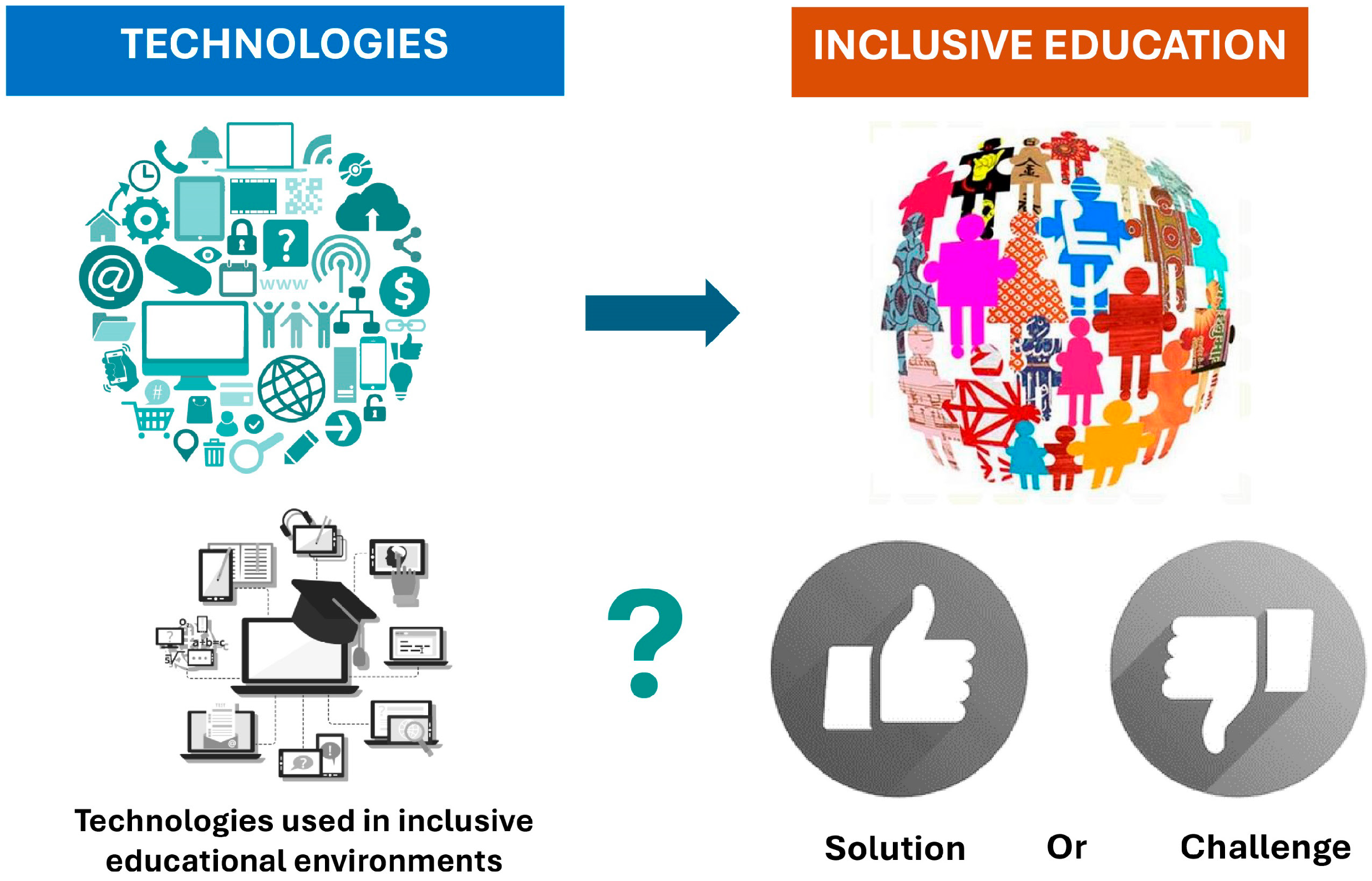
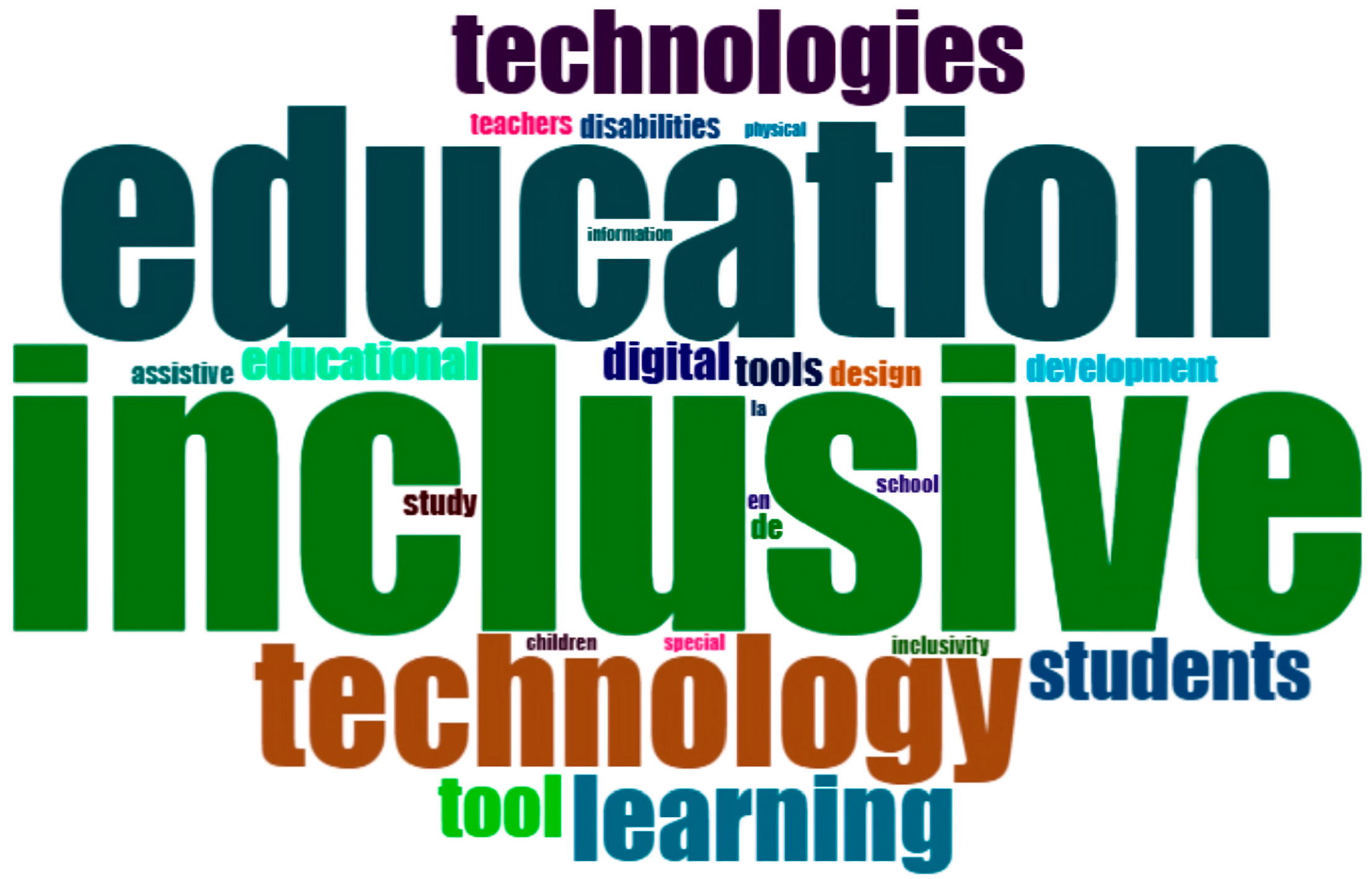
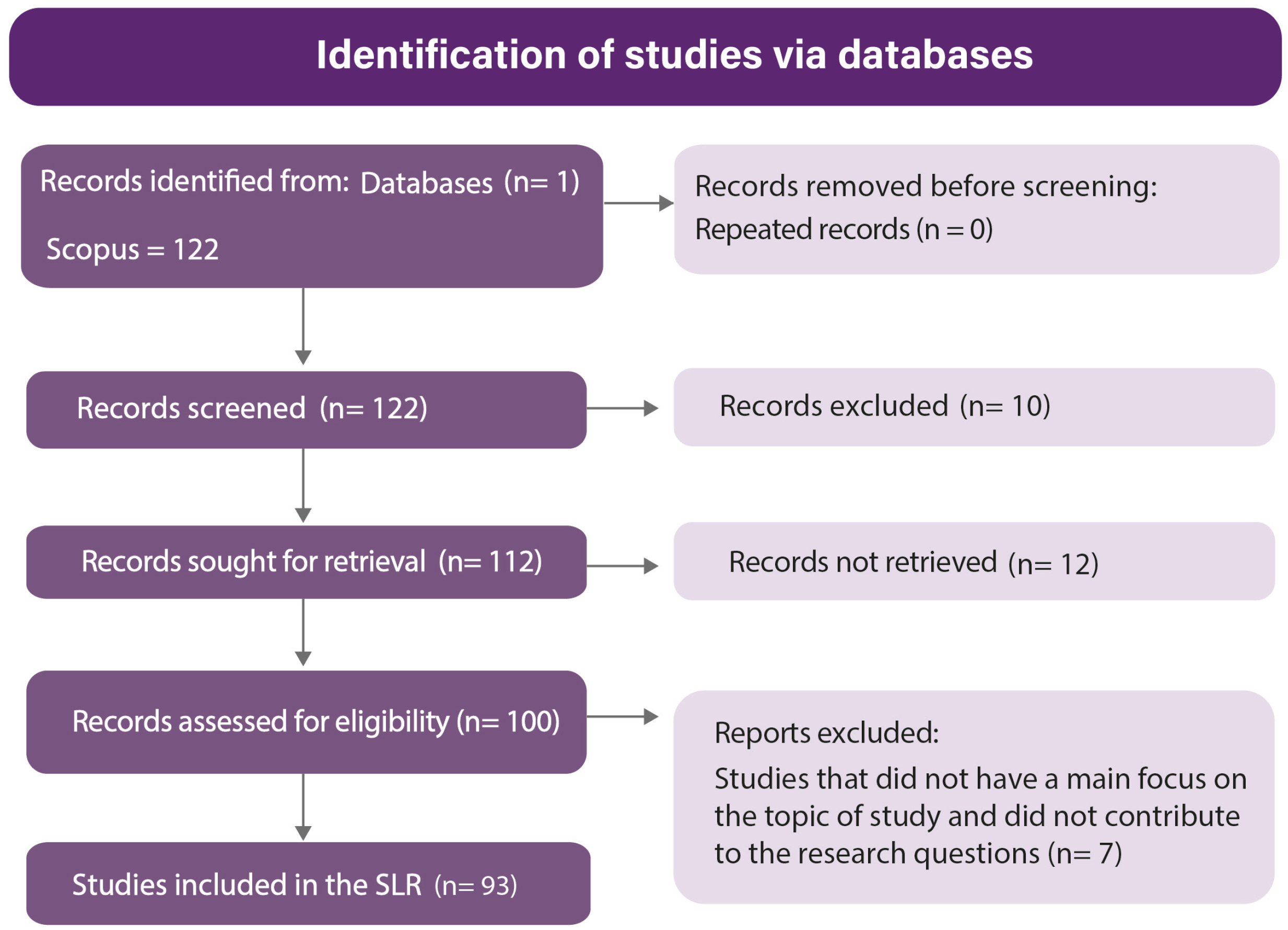
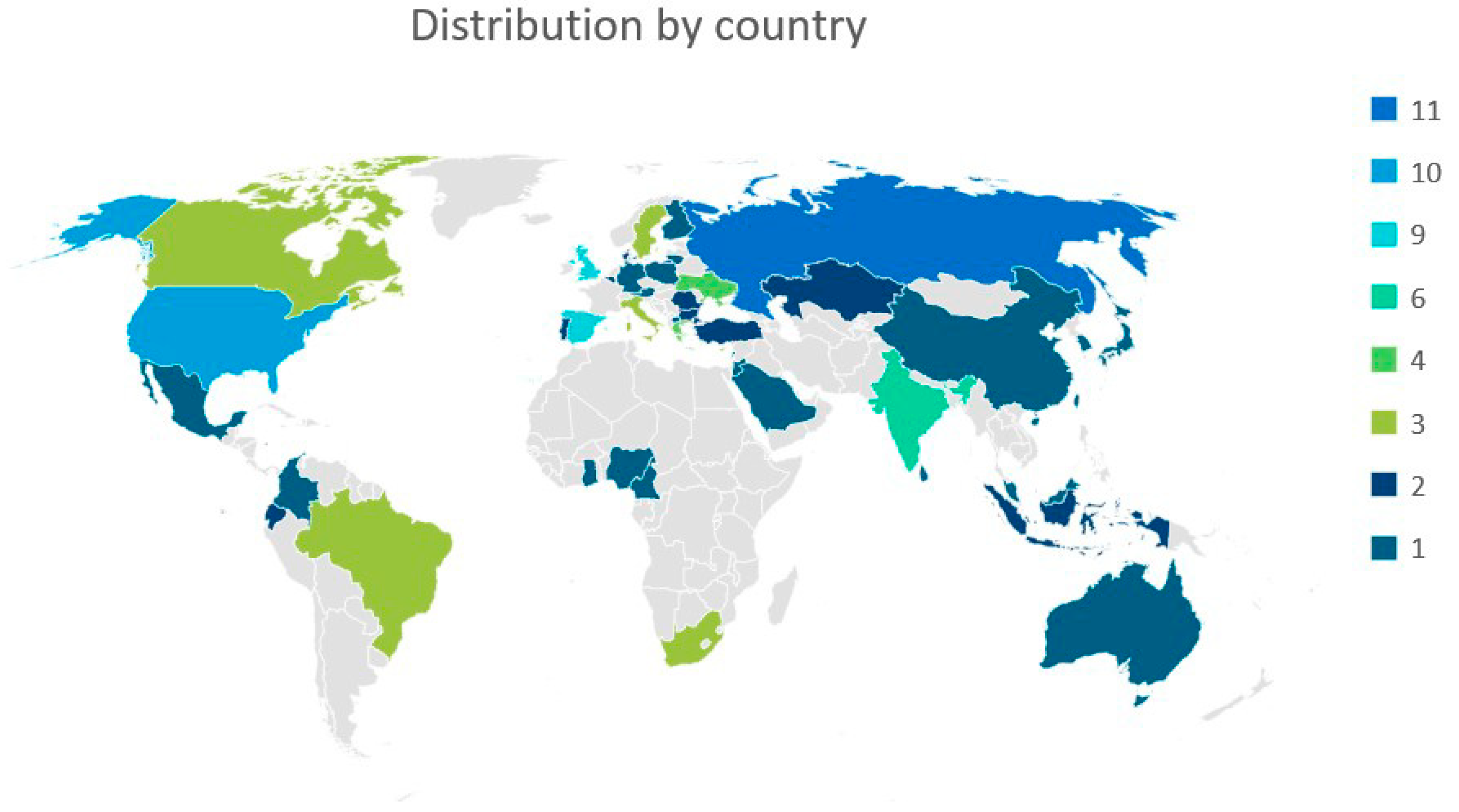


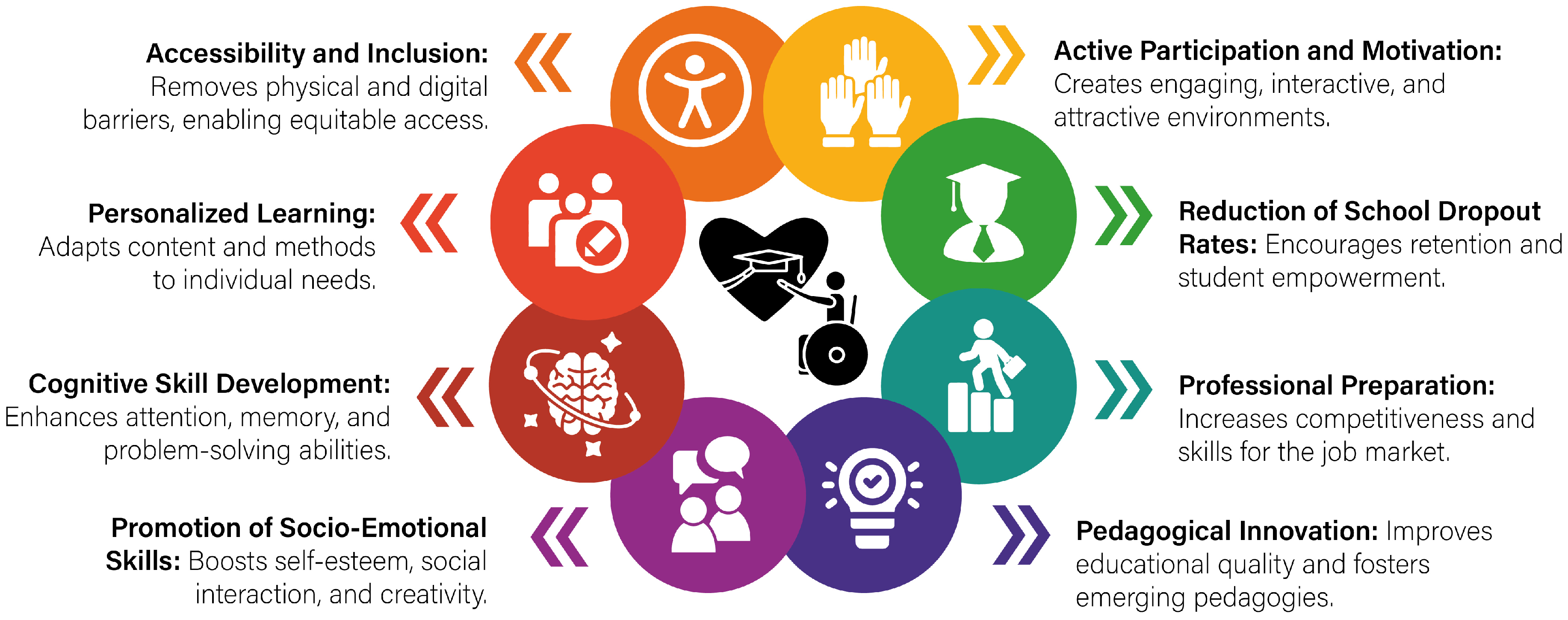
Disclaimer/Publisher’s Note: The statements, opinions and data contained in all publications are solely those of the individual author(s) and contributor(s) and not of MDPI and/or the editor(s). MDPI and/or the editor(s) disclaim responsibility for any injury to people or property resulting from any ideas, methods, instructions or products referred to in the content. |
© 2025 by the authors. Licensee MDPI, Basel, Switzerland. This article is an open access article distributed under the terms and conditions of the Creative Commons Attribution (CC BY) license (https://creativecommons.org/licenses/by/4.0/).
Share and Cite
Samaniego López, M.V.; Orrego Riofrío, M.C.; Barriga-Fray, S.F.; Paz Viteri, B.S. Technologies in Inclusive Education: Solution or Challenge? A Systematic Review. Educ. Sci. 2025, 15, 715. https://doi.org/10.3390/educsci15060715
Samaniego López MV, Orrego Riofrío MC, Barriga-Fray SF, Paz Viteri BS. Technologies in Inclusive Education: Solution or Challenge? A Systematic Review. Education Sciences. 2025; 15(6):715. https://doi.org/10.3390/educsci15060715
Chicago/Turabian StyleSamaniego López, Mariela Verónica, Monserrat Catalina Orrego Riofrío, Santiago Fabián Barriga-Fray, and Bertha Susana Paz Viteri. 2025. "Technologies in Inclusive Education: Solution or Challenge? A Systematic Review" Education Sciences 15, no. 6: 715. https://doi.org/10.3390/educsci15060715
APA StyleSamaniego López, M. V., Orrego Riofrío, M. C., Barriga-Fray, S. F., & Paz Viteri, B. S. (2025). Technologies in Inclusive Education: Solution or Challenge? A Systematic Review. Education Sciences, 15(6), 715. https://doi.org/10.3390/educsci15060715






